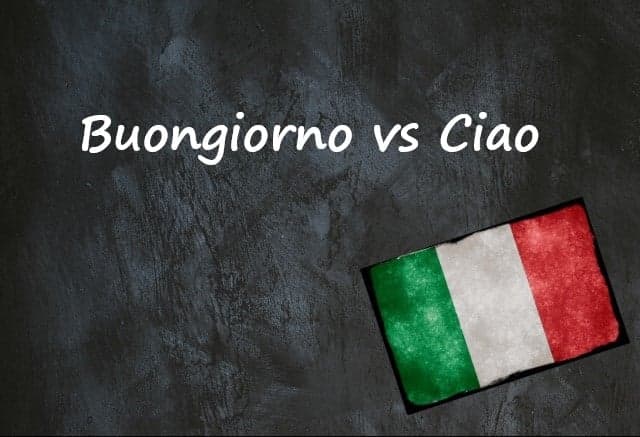Italian word of the day: Buongiorno vs Ciao

These Italian words are both common greetings, but there are important differences around the context in which they should be used.
It’s often the case in Italy that you’ll find several words that mean something very similar, and it’s not always easy to know which one is appropriate. Our new mini series looks at some of the most common word pairs, and sorts out which should be used and when.
Why do I need to know the difference between buongiorno and ciao?
Because you'll need to use both of them daily if you live in Italy, but they're easy to use at the wrong moment. Both are greetings, but one is more casual than the other.
What's the difference?
Buongiorno – hear the pronunciation here – is one Italian word known across the world, even to people who do not speak the language.
It effectively means "good morning", or simply "hello". It translates literally as "good day", though it's more usually used earlier in the day (find out more about when exactly to switch to buonasera in a separate article).
Ciao – hear the pronunciation here – is probably just as well-known abroad. This word is part of the language in some other European countries too, including in central and eastern Europe, with variations on spelling.
In Italian, ciao is often translated as ‘hi’, but it can be more informal than that – it’s also similar to ‘hey’ and it’s a greeting to be used among friends, colleagues or people you know well.
While in the anglophone world it would be perfectly acceptable to greet a server or sales assistant with ‘hi’, in Italian ciao would be a bit too informal, so you would use buongiorno here.
READ ALSO:
- Come stai vs come va
- When do Italians switch from buongiorno to buonasera?
- How to answer the phone in Italian
You could start a casual email with ‘buongiorno’ but you would be unlikely to start an email or formal correspondence with ‘ciao’. That said, it is often used to start a text message conversation.
If you’re not sure which is appropriate, it’s probably best to stick to buongiorno unless you know the person well.
Ciao also has a superpower – it doubles as an informal 'bye', unlike buongiorno which can only be used for ‘hello’.
Examples
Ciao Clara, sono sotto casa. Puoi lasciarmi entrare? – Hi Clara, I’m downstairs. Can you let me in?
Buongiorno signore, il suo tavolo è pronto – Hello sir, your table is ready.
And there are of course several other greetings you might use, including salve and buonasera: read more about those here.
Do you have an Italian word you’d like us to feature? If so, please email us with your suggestion.
Make sure you don’t miss any of our Italian words and expressions of the day: download our new app (available on Apple and Android) and then selecting the Italian Word of the Day in your Notification options via the User button.
Comments
See Also
It’s often the case in Italy that you’ll find several words that mean something very similar, and it’s not always easy to know which one is appropriate. Our new mini series looks at some of the most common word pairs, and sorts out which should be used and when.
Why do I need to know the difference between buongiorno and ciao?
Because you'll need to use both of them daily if you live in Italy, but they're easy to use at the wrong moment. Both are greetings, but one is more casual than the other.
What's the difference?
Buongiorno – hear the pronunciation here – is one Italian word known across the world, even to people who do not speak the language.
It effectively means "good morning", or simply "hello". It translates literally as "good day", though it's more usually used earlier in the day (find out more about when exactly to switch to buonasera in a separate article).
Ciao – hear the pronunciation here – is probably just as well-known abroad. This word is part of the language in some other European countries too, including in central and eastern Europe, with variations on spelling.
In Italian, ciao is often translated as ‘hi’, but it can be more informal than that – it’s also similar to ‘hey’ and it’s a greeting to be used among friends, colleagues or people you know well.
While in the anglophone world it would be perfectly acceptable to greet a server or sales assistant with ‘hi’, in Italian ciao would be a bit too informal, so you would use buongiorno here.
READ ALSO:
- Come stai vs come va
- When do Italians switch from buongiorno to buonasera?
- How to answer the phone in Italian
You could start a casual email with ‘buongiorno’ but you would be unlikely to start an email or formal correspondence with ‘ciao’. That said, it is often used to start a text message conversation.
If you’re not sure which is appropriate, it’s probably best to stick to buongiorno unless you know the person well.
Ciao also has a superpower – it doubles as an informal 'bye', unlike buongiorno which can only be used for ‘hello’.
Examples
Ciao Clara, sono sotto casa. Puoi lasciarmi entrare? – Hi Clara, I’m downstairs. Can you let me in?
Buongiorno signore, il suo tavolo è pronto – Hello sir, your table is ready.
And there are of course several other greetings you might use, including salve and buonasera: read more about those here.
Do you have an Italian word you’d like us to feature? If so, please email us with your suggestion.
Make sure you don’t miss any of our Italian words and expressions of the day: download our new app (available on Apple and Android) and then selecting the Italian Word of the Day in your Notification options via the User button.

Join the conversation in our comments section below. Share your own views and experience and if you have a question or suggestion for our journalists then email us at [email protected].
Please keep comments civil, constructive and on topic – and make sure to read our terms of use before getting involved.
Please log in here to leave a comment.